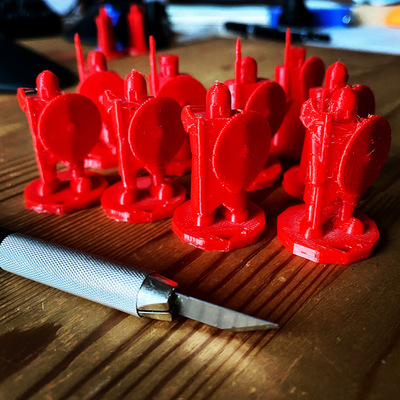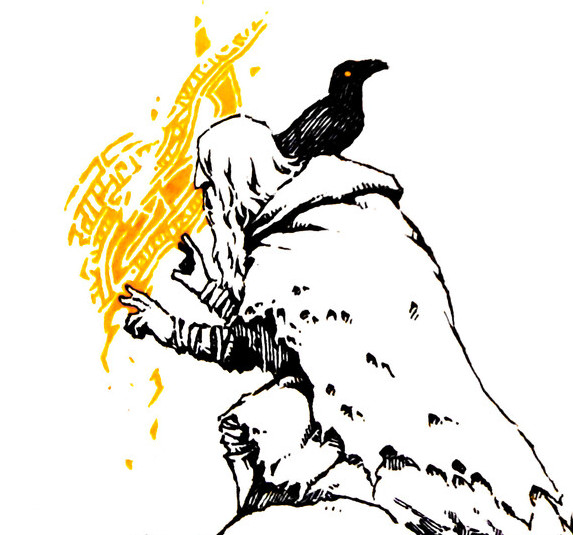
|
Thread Weaving |
| 2021-02-11 |
Thread Weaving

I am tinkering a magic system for my table, my own magic system train wreck.
My first attempt was the weaver added to the slim 5e we were using. I wanted to have magic points and a single caster class.
We moved to Wolves of God and siblings, and I still want a single casting class. Back to the weaver.
This is work in progress, in a repository covered by CC-BY-SA 4.0.
This post is a kind of "state of the work in progress", as I unravel the system, I hope to document the design decisions behind it and record them here.
Weavers are persons with the gift of weaving, weaving magical threads to achieve effects.
The gift doesn't seem hereditary. The majority of the weavers consider it a curse rather than a gift and hide it. A minority of people are weavers. Some weavers don't even know they have the gift, they might be gifted but blind, they don't see the threads although they trigger the weaving.
Some non-gifted people, through their friendship with a weaver know of the gift. They keep the secret for fear of their friend to be discovered. Some non-weavers abuse weak weavers and use them but keep the silence.
A weaver sees the thread they weave. Non-weavers don't seem to see threads, although some might... A weaver doesn't see the threads another weaver makes, unless they use a thread-revealing spell.
Colours are known to many cultures. Different spells have different thread colours. It seems that the black threads are about pain and damage for all the weavers, and that blue threads generate cold or nullify heat were they appear, these are two examples.
Weavers seem to agree on colours, but there may be some of them with twisted perception of the colours (as written above, some are even blind to the threads).
Balls, arrows, huts are known to many cultures. A simple vocabulary emerged around forms and colours, they easily translate from a language to the other. Weaver may thus easily describe what they are trying to achieve to each other.
Some travelled weavers say that in Constantinople or in the Caliphate, there are more colours and more forms and sophistication, but it'd take a lifetime to ascertain.
This explanation of weavers starts with things common to the 5e weaver class, but it ends with colours and forms. The 5e weaver was meant to use 5e spells. I was thinking I would cherry pick spells that fit well the "weaving threads" concept.
But I am pressing forward with my own spells for this new weaver class.
Since weavers are gifted, they don't draw their magic out of theory, it manifests to them as threads of colours woven in forms.
The colours are for now Amber (Heat), Black (Damage), Blue (Cold), Night (Darkness), Quartz (Meta), Red (Fire), Scarlet (Drain), Silver (Fence), Turquoise (Healing), and White (Light).
The forms are
| form | ct | diameter | range | duration | speed (per rnd) |
|---|---|---|---|---|---|
| Arrow | main action | - | long (80 ft per WP) | 1 rnd per WP | 80 ft per WP |
| Ball | main action | 1 ft per WP | medium (30 ft per WP) | 1 rnd per WP | 30 ft per WP |
| Disk | main action | 5 ft per WP | short (10 ft per WP) | 10 min per WP | 0 |
| Finger | main action | - | touch | 1 rnd | 0 |
| Hand | main action | - | touch | 1 rnd | 0 |
| Hut | 2 main actions | 5 ft per WP | close (5 ft per WP) | 1 min per WP | 0 |
| Pole | main action | - | short (10 ft per WP) | 1 rnd | 0 |
| Shield | main action | broad shield | touch | 1 min per WP | 0 |
| Tunnel | main action | 5 ft per WP | medium (30 ft per WP) | 1 min per WP | 80 ft per WP |
| Well | main action | 5 ft per WP | close (5 ft per WP) | 1 min per WP | 80 ft per WP |
This brings in WP, Weave Points. Casting a spell costs at least one weave point.
Weaver cast spells by consuming Weave Points (hereafter WP or WPs).
After a good night rest, a Weaver disposes of their level plus their level times the best of their INT, WIS, or CHA modifier. Thus a level 2 Weaver with +2 in INT, disposes of 2 + 2 * 2 = 6 WP.
casting cost in WPs
Casting a spell costs at least 1 WP. The Weaver decides how many WPs they use right before casting. The Weaver cannot go below zero WPs.
A weaver can, as an instant action, convert some of his HPs to WPs. The weaver must "spare" at least 1 HP.
Once the WP are consumed, a skill check against a difficulty of 8 has to be rolled 2d6 + Magic skill + attribute modifier.
The attribute modifier is either INT, WIS, or CHA, the Weaver decides which one to use, guided by the GM. In a given scene, the same modifier cannot be used twice in a row. For example, a Weaver cannot cast a spell with an INT modifier and then another (or the same spell) with an INT modifier, they must use the WIS or the CHA modifier.
The Weaver (or the GM) are invited to "roleplay" the spell depending on the att modifier used. INT cold logic, WIS street smart, CHA force of will.
If the roll fails, the weavery fails, the WP are consumed anyway.
becoming frail to obtain WPs
A Weaver may accept become "frail" (see Injury) and immediately gain 1d6 WP plus the best of its INT, CHA, or WIS modifiers.
casting at risk
A Weaver may accept a risk to reduce by one the WP cost of casting a spell. The minimal cost is still 1 WP. If the skill check results in a double 1, the cast fails, and 1d6 HPs have to paid by the caster or creatures within 5 feet. The GM determines who bears the extra cost and by how much. The caster must pay at least 1 HP or 1 WP, other designated targets must pay in HPs.
known spells
A Weaver is usually granted 1 or 2 spells at level 1. As the Weaver gains experience, the GM considers their trail and hint at new spells. The GM may "loan" spells to the Weaver and eventually take them back. Two spells per level might be a good number for the known spells.
So, where are the magic missiles?
10 thread colours times 10 spell forms (shapes), that makes for a hundred potential spells. I have started writing some of them.
Maybe the closest to an underpowered magic missile would be the black arrow.
## Black Arrow * **Casting Time:** main action * **Range:** long (80 feet per WP) * **Diameter:** - * **Duration:** 1 rnd per WP * **Speed:** 80 ft per WP Fires an arrow of weaving pain at a single target. | WP | damage | |----|-------------| | 1 | 1d4 + skill | | 2 | 1d6 + skill | | >3 | 1d8 + skill | Skill is the Magic skill level.
Identify could be covered by Quartz Ball.
## Quartz Ball * **Casting Time:** main action * **Range:** medium (30 feet per WP) * **Diameter:** 1 ft per WP * **Duration:** 1 rnd per WP * **Speed:** 30 ft per WP A reveal ball, within its radius, a thread outlines threads left by other casters. The colours of those threads is revealed. Only the threads within the radius of the ball are outlined by the quartz thread. By consuming 1 extra WP, all the threads (quartz and others) are revealed to other weavers. Non weavers must succeed a DD 8 WIS / Magic skill check to see. The GM may decide that some characters or creatures are thread blind and simply cannot see. The ball might be quite smaller than the form of the thread it reveals. Blind man and elephant situation.
Although a weaver might not have a clue of the other threads colour domain.
The first version of the weaver class granted the ability to drain HPs for WPs from other living creatures, starting at 6th level.
For this new version of the weaver, I intend to give the ability through scarlet coloured spells.
## Scarlet Hand * **Casting Time:** main action * **Range:** touch (touch) * **Diameter:** - * **Duration:** 1 rnd The weaver lays their hand on the wound of a living target and weave threads that drain the the wounded of some of their hit points. The target suffers 1d6 + skill damage which are turned to WPs and added to the weaver's current WP count. (Remember that weaving requires at least 1 WP, so the in the worst case, the weaver might gain 1 - 1 WPs and the target might lose 1 HP).
It's not an level ability anymore, it's a family spells, the weaver may know one of them and may thus drain other creatures for WPs. It's subject to spellcasting rules, nothing special.
There are no spell levels, spells have cost, their size and duration vary by form and WP consumed. My hope is that if the "dimensions" are form-bound and not spell-bound, there is less to look up before casting. A ball is a 1 foot diameter ball all the time, the smallest hut fits in a 5 foot square and cal hold 2 people, etc.
Weaver must know spells. I still want, as the GM, to observe the weaver's play and gift them spells as they progress. I have those two axes, colours and shapes. My weaver knows the silver hut, I can go one step and gift them black hut or one step in another direction and grant them silver arrow.
It doesn't close the door to more complicated forms (shapes), as written above, there may be, in Constantinople or in the Caliphate, weavers that went beyond the simplistic forms fathomed out by our lonely dark age weavers.
Magic system train wreck in progress at https://github.com/jmettraux/aac_magic
UPDATE 2021-02-11 Alex Schroeder pointed me at his "magic words" post, that places my experiment in a big list of similar experiments.
